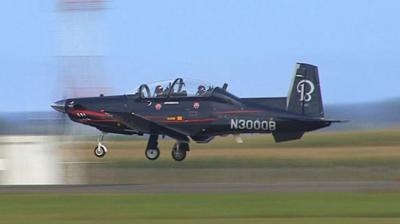Aircraft Had Been Subject To An Operational Pause Traced To Oxygen System Issues
Air Force Materiel Command is playing a lead role in analyzing unexplained physiological events with the T-6 Texan II training platform.

Maj. Gen. T. Glenn Davis, AFMC mobilization assistant to the commander, is leading a team to determine the root causes and corrective actions for recent T-6 aircrew breathing system problems. Gen. Ellen Pawlikowski, AFMC commander, and Darlene Costello, principal deputy assistant secretary of the Air Force for Acquisition and Logistics, convened the team and appointed Davis to lead it.
As part of the Air Force’s root cause investigatory actions, the 412th Test Wing at Edwards Air Force Base will characterize the T-6 aircrew breathing system through all phases of flight. Testing will start in early April and conclude by mid May 2018. Two Air Education and Training Command T-6 aircrafts, one with a physiological event history and one without, will support this test.
AETC announced an operational pause for all T-6 operations directed by Maj. Gen. Patrick Doherty, 19th Air Force commander, following a cluster of UPEs at three AETC pilot training bases Feb. 1, 2018. On Feb. 27, AETC officials announced a return to flight after its initial investigation focused on issues with the T-6 On-Board Oxygen Generating System.
In announcing AETC’s return to fly decision, Doherty noted while no definitive root cause for the UPEs has been determined, data gathered to date noted a number of issues involving components associated with the delivery of aircrew oxygen, which were failing at unexpected rates, likely resulting in degraded OBOGS performance.

According to the program office, "the operational safety, suitability and effectiveness parameters of the T-6 remain the top priority of the Air Force.” Davis noted, as part of proactive life cycle management, the Air Force has an ongoing program to replace the existing OBOGS concentrator with fielding starting in fiscal year 2018 and ending in fiscal 2021. In addition to preserving system reliability, this concentrator will improve maintainability and record system performance data that can be useful in determining root cause of potential physiological events.
Concurrent with the start of the T-6 concentrator replacement effort, Davis said the Air Force continues to investigate the root cause of the recent UPEs in the aircraft and is poised to take further appropriate action on any findings.
In his role as T-6 Aircrew Breathing System Team lead, Davis is responsible for the root cause investigation, including medical and engineering considerations addressing hypoxia-like symptoms, toxicology, flight equipment, aircraft subsystems including cockpit pressurization, cabin air, maintenance and operating procedures. “We’re working aggressively to analyze a number of potential causation tracks, but our analysis is in the very early stages, so we’re not ready to identify specific causal factors to the recent UPEs,” said Davis. “AFMC and AETC officials are working together to ensure that pilots are safe as we continue to fulfill the vital pilot production mission.”
Davis said the multi-disciplinary team includes functional experts from several Air Force major commands, including another AFMC organization, the Air Force Research Laboratory's 711th Human Performance Wing. Its sophisticated On-Board Oxygen System Laboratory at Wright-Patterson AFB performs research on existing OBOGS in simulated flight environments with the goal of eliminating UPEs and improving OBOGS performance across the flight envelope. Their ongoing efforts support multiple Air force platforms.
(Source: USAF news release. Images from file)
 ANN's Daily Aero-Term (04.28.24): Airport Marking Aids
ANN's Daily Aero-Term (04.28.24): Airport Marking Aids Aero-News: Quote of the Day (04.28.24)
Aero-News: Quote of the Day (04.28.24) ANN's Daily Aero-Linx (04.28.24)
ANN's Daily Aero-Linx (04.28.24) Aero-News: Quote of the Day (04.29.24)
Aero-News: Quote of the Day (04.29.24) ANN's Daily Aero-Linx (04.29.24)
ANN's Daily Aero-Linx (04.29.24)




